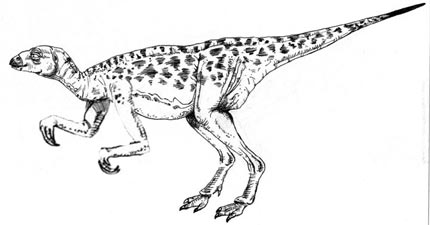Scientists on the Isle of Wight Announce New Dinosaur Fossil Find
Fossil Location Kept Secret as Palaeontologists Plan to Excavate
Palaeontologists on the Isle of Wight (off the coast of southern England), are hoping that the discovery of an almost perfectly preserved set of fossilised dinosaur bones will help them to solve a mystery that is itself more than 100 years old.
The fossil material has been tentatively described to a genus of ornithopod (bird-hipped) dinosaur called Valdosaurus. Up until now most of the fossil specimens, including the holotype material from which this plant-eating dinosaur was named, have been disarticulated and fragmentary. These new fossils described by Isle of Wight palaeontologists as “absolutely amazing” represent a single individual but the fossils are articulated and much more of the skeleton has been preserved.
Dinosaur Fossil
The fossils were found last Autumn by a walker who observed a series of bones slowly eroding out of a block of rock on a cliff face on the island’s south-west coast. The exact location is being kept a closely guarded secret as scientists hope to be able to return to the site to look for further fossil evidence. The land is owned by the National Trust and permission was granted for the palaeontologists to remove several large blocks of sandstone from the site so that the fossils could be carefully extracted from their surrounding matrix under laboratory conditions. The seven sandstone blocks contained much of the rear end of the skeleton including articulated caudal vertebrae (tail bones), elements from the pelvis, hind limbs and parts of the backbone.
Not a Cretaceous Crocodile
At first the scientists thought that the fossils represented a prehistoric, Early Cretaceous crocodile, but as the bones were revealed with the removal of the surrounding sandstone it soon became clear that they had an exceptionally well-preserved example of a Valdosaurus, perhaps the most complete specimen of this type of dinosaur discovered to date.
Scientists have remained uncertain as to the size of Valdosaurus and how closely it was related to other ornithopods. It is hoped that these fossils will help to answer the many questions surrounding this herbivore from the Early Cretaceous. Fossils ascribed to Valdosaurus have been found on the Isle of Wight and also from Weald Clay material located in West Sussex (southern England). This new specimen suggests a body length of around 3.6 metres (12 feet), although some fragmentary remains now housed at the Natural History Museum in London suggest that a fully grown Valdosaurus could have reached a length in excess of five metres.
Everything Dinosaur’s Interpretation of Valdosaurus
Picture credit: Everything Dinosaur
Once thought to be a type of theropod (meat-eating) dinosaur, Valdosaurus has been described as being a light, fast running, medium-sized browser feeding from the ground level to up to around two metres.
In Everything Dinosaur’s illustration we have given our Valdosaurus slightly longer arms than in representations of other dryosaurids. It is thought that this dinosaur was a facultative quadruped.
Although it will take some months to complete the preparation of the fossil material, palaeontologists are hopeful that this specimen will be able to go on display at a dinosaur museum on the island, forming part of a new exhibit about the plant-eating dinosaurs that once roamed this part of the world.
To read an article highlighting the importance of the Isle of Wight to palaeontologists: Isle of Wight Declared the “Dinosaur Capital” of the British Isles.
The fossil material has been dated to approximately 128 million years ago (Barremian faunal stage of the Early Cretaceous). Valdosaurus has been classified as a dryosaurid, although it remains uncertain as to the exact taxonomic relationship this dinosaur genus has to Dryosaurus (best known from Upper Jurassic strata of the western United States) and to Camptosaurus.
It is not known whether this specimen represents a new species of Valdosaurus. The name of this dinosaur means “Weald lizard”, reflecting the fact that much of the material ascribed to this genus has come from the Weald Clay of West Sussex.
For figures and repilicas of iguanodontids and other ornithopods: CollectA Prehistoric Life (Popular) Models.


